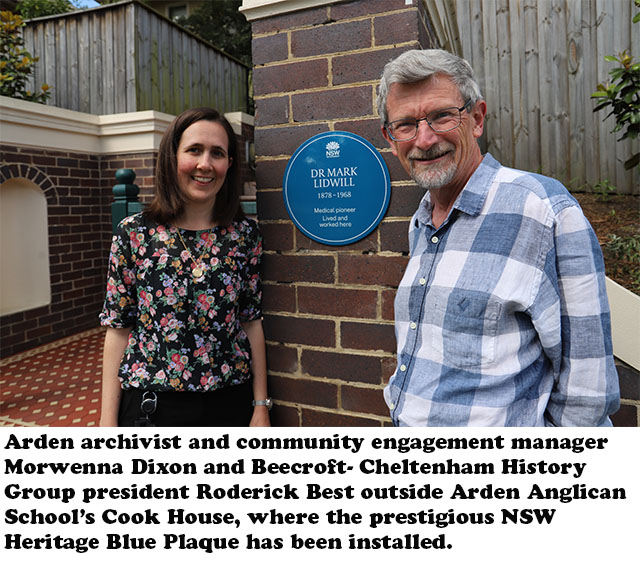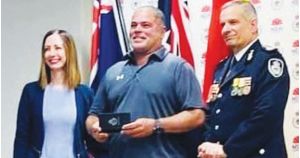When you whizz past Arden Anglican School’s Junior Campus on Beecroft Road, you may have noticed the handsome historic building that fronts the street.
Cook House, as it’s now known, was originally the home of Dr Mark Cowley Lidwill, an Australian medical pioneer crediting with inventing the world’s first cardiac pacemaker.
His contribution has now been recognised with a NSW Heritage Blue Plaque, installed at the street entrance to the school, designed to draw attention to extraordinary people who have made a significant contribution to NSW life.
Only 21 Blue Plaques have been allocated so far throughout NSW, making the Lidwill plaque – officially unveiled on October 14 by Member for Epping and NSW Premier Dominic Perrottet – very special, according to Beecroft-Cheltenham History Group president Roderick Best.
“The heritage conservation area of Beecroft-Cheltenham is the biggest in the Hornsby Shire,” said Mr Best, who led the submission to NSW Heritage.
“Over 700 nominations for Blue Plaques came in from across the state, with only 17 being awarded.
“We thought that Mark Lidwill deserved the recognition due to his international standing, and we had a clear documented history to draw on.”
The historic significance of Cook House, previously known as ‘Lorne’, brings another element to the placing of the plaque, with the house a beautiful example of the arts and crafts style.
Dr Lidwill built Lorne in 1908 as a two-storey residence in Beecroft that also housed his general practice.

After graduation he moved to Sydney and in 1913 was appointed as the first lecturer in anaesthetics at the Royal Prince Alfred Hospital.
That same year, Dr Lidwill invented a portable machine for anaesthesia, the Lidwill Inter-tracheal Anaesthetic Machine. Patented in 1921, the device was used in Australian hospitals for more than three decades.
Some years later, upon discovering that electricity could be used to stimulate the heart, Dr Lidwill and physicist Edgar H. Booth devised a portable apparatus that was able to ‘pace’ the heart rate at about 80 to 120 pulses per minute. The machine was first used in 1928 to resuscitate a newborn baby.
Arden archivist and community engagement manager, Morwenna Dixon, said she was delighted that the significance of both Dr Lidwill and Cook House had been marked.
“It is wonderful to have Dr Lidwell’s contribution to NSW recognised in this way,” said Mrs Dixon.
“Cook House has had connections to Arden for over 60 years, yet the achievements of the building’s original owner are not well known throughout the community.
“To celebrate the unveiling of the Blue Plaque in our Centenary year makes it even more special.” She added that the granting of the plaque would not have been possible without the work of the Beecroft Cheltenham History Group.
You can read more about Mark Lidwill and other local historical figures at the Beecroft-Cheltenham History Group website – www.bchg.org.au









